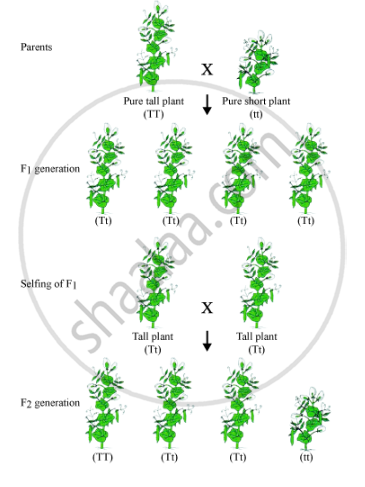Advertisements
Advertisements
प्रश्न
"A trait may be inherited, but may not be expressed." Justify this statement with the help of a suitable example.
उत्तर १
Let us take the following example to justify the above statement.
Mendel crossed tall pea plants with dwarf pea plants.

Mendel's Observation
F1 generation contained all tall plants. When F1 generation underwent selfing, the trait that was unexpressed in F1(dwarf) was observed in some F2 progeny. Thus, both traits, tall and dwarf, were expressed in F2 generation in the ratio 3:1.
The above experiment indicates that although both the traits of tallness and shortness were inherited in F1 plants, only the tallness trait was expressed. This shows that traits may not show up in an individual but are passed on to the next generation.
उत्तर २
Some traits are determined by the combined effect of more than one pair of genes. These are referred to as polygenic or continuous, traits.
An example of this is human stature. The combined size of all of the body parts from head to foot determines the height of an individual. There is an additive effect. The sizes of all of these body parts are, in turn, determined by numerous genes. Human skin, hair, and eye color are also polygenic traits because they are influenced by more than one allele at different loci. The result is the perception of continuous gradation in the expression of these traits.
APPEARS IN
संबंधित प्रश्न
Name the information source for making proteins in the cells.
Mendel crossed tall pea plants with dwarf pea plants in his experiment. Write his observations giving reason on the F1 and F2 generations.
List any two contrasting characters other than roundness of pea plants that Mendel used in his experiments with pea plants.
A man having blood group O marries a woman having blood group B and they have a daughter. What will be the blood group of the daughter?
What will you get in the F1 and F2 generations in the following cross?
Pure tall pea plant × Pure dwarf pea plant
In the human blood grouping, the four basic blood types are type A, type B, type AB, and type O. The blood proteins A and B are :
(a) simple dominant and recessive traits
(b) incomplete dominant traits
(c) codominant traits
(d) sex-linked traits
A cross between a tall plant (TT) and short plant (tt) resulted in progeny that were all tall plants because :
(a) tallness is the dominant trait
(b) shortness is the dominant trait
(c) tallness is the recessive trait
(d) height of plant is not governed by gene T or t
"It is possible that a trait is inherited but may not be expressed." Give a suitable example to justify this statement.
Answer the following question.
Why are the traits acquired during the life-time-of-an individual not inherited? Explain.
____________ refers to the transmission of genetic information from parental generation to next generation.
